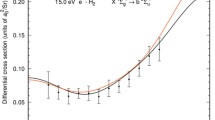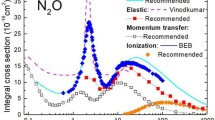Abstract
We have analyzed a large set of mean energies and angular anisotropies for evaporative4He emission to obtain barriers to evaporation,B. These exit channel barriers are often substantially smaller than the corresponding empirical s-wave fusion barriersE 0. The differences (E 0-B) are interpreted as indicators of the extent of distortion of the emitters. These distortions have in turn been characterized by the deformation parameter for a spheroid α20. ForZ=80 the dependence ofB or {α}20 on spin is somewhat suggestive of the superdeformed shapes predicted by the liquid drop model. ForZ>70 significant distortions are indicated for emitters of both large and small spin.
Similar content being viewed by others
References
Swiatecki, W.J.: Prog. Part. Nucl. Phys.4, 383 (1980) and Lawrence Berkeley Laboratory Reports LBL 10911 (1980) and 12642 and 12708 (1981) (unpublished)
Delagrange, H., Logan, D., Rivet, M.F., Rajagopalan, M., Alexander, J.M., Eisman, M.S., Kaplan, M., Ba-l, J.W.: Phys. Rev. Lett.43, 1490 (1979)
Logan, D., Rajagopalan, M., Zisman, M.S., Alexander, J.M., Kaplan, M., Kowalski, L.: Phys. Rev. C22, 104 (1980)
Logan, D., Kaplan, M., Zisman, M.S., Duek, E.: Phys. Rev. C22, 1080 (1980)
Vaz, L.: Unpublished data (1981)
Rivet, M.F., Logan, D., Alexander, J.M., Guerreau, D., Duek, E., Zisman, M.S., Kaplan, M.: Phys. Rev. C (in press)
Kildir, M., Logan, D., Kaplan, M., Zisman, M.S., Guerreau, D., Alexander, J.M., Vaz, L.C.: Z. Phys. A - Atoms and Nuclei (in press)
McMahan, M.A., Alexander, J.M.: Phys. Rev. C21, 1261 (1980); Vaz, L.C., Alexander, J.M.: Phys. Rev. C10, 464 (1974)
Vaz, L.C., Alexander, J.M., Satchler, G.R.: Phys. Rep. C69, 373 1981 (and references therein)
Reedy, R.C., Fluss, M.J., Herzog, G.F., Kowalski, L., Miller, J.M.: Phys. Rev.188, 1771 (1969)
Galin, J., Gatty, B., Guerreau, D., Rousset, C., Schlotthauer-Voos, U.C., Tarrago, X.: Phys. Rev. C9, 1113, 1126 (1974); C10, 638 (1974)
Guerreau, D., Rivet, M.F., Logan, D., Alexander, J.M., Vaz, L.C., Duek, E., Kowalski, L., Zisman, M.S.: (to be published)
Catchen, G.C., Kaplan, M., Alexander, J.M., Rivet, M.F.: Phys. Rev. C21, 940 (1980)
Benvenist, J., Merkel, G., Mitchell, H.: Phys. Rev.174, 1357 (1968)
Lu, C.C., Vaz, L.C., Huizenga, J.R.: Nucl. Phys. A197, 321 (1972)
Chenevert, G., Halpern, I., Harvey, B.G., Hendrie, D.L.: Nucl. Phys. A122, 481 (1968)
Gilat, J., Grover, J.R.: Phys. Rev. C3, 734 (1971)
Guerreau, D., Babinet, R.: J. Phys. (Paris) C10, 217 (1980)
Delia Negra, S., Gauvin, H., Jungclass, H., Le Beyec, Y., Lefort, M.: Z. Phys. A — Atoms and Nuclei282, 63 and 75 (1977)
Moretto has developed many aspects of the transition-state theory of evaporation, Moretto, L.G.: Nucl. Phys. A247, 211 (1975). In this approach the thermal contribution to the average energy 《ɛ》 depends on the number of “amplifying and nonamplifying modes” that are effective at the saddle point for evaporation. At this time it is not possible to choose this number unambiguously either from theory or from the empirical evidence. However it seems that (1) (from evaporation theory [3]) does correspond to a reasonable choice of modes in this transition-state theory. Other reasonable choices might give somewhat larger thermal contributions to 《ɛ》 and therefore somewhat smaller values ofB
Several of the reactions listed in Table 1 lead to very low effective excitation energies (He+Fe, Co, Ni, Cu and40Ar +Se). We have included them for completeness, but the conditions for validity of (1) are actually not well satisfied. For low thermal excitation energies the constant temperature approximation fails for the level density. In addition, for the reactions of40Ar with Se, the spin cutoff constraints of nearyrast emission may well become severe [8], and the sharp cutoff transmission coefficients may well be inadequate. These latter reactions are particularly interesting for exploring the spin dependence of the emission barriers. However a very detailed analysis (similar to but more extensive than that in [8]) is required. At this time we simply adopt the values of Z,A andE * from the14N induced reactions for the40Ar reactions
Wong, C.Y.: Phys. Lett.26 B, 120 (1968)
Moretto's discussion of evaporation [17] and Swiatecki's model of fusion [1] both imply significant shape changes between the effective saddle points for fusion and that for evaporation. In the framework of [1] (proximity potential plus neck degree of freedom) these saddle points could differ in energy by 5–10%. To the degree that energy is tied up in neck formation (for the evaporation saddle point) our values of α20 fromB′/E 0 will be overestimated
Cohen, S., -Plasil, F., Swiatecki, W.J.: Ann. Phys. (N.Y.)82, 557 (1974)
Blann, M.: Phys. Rev. C21, 1770 (1980)
Rajagopalan, M., Logan, D., Ball, J.W., Kaplan, M., Delagrange, H., Rivet, M.F., Alexander, J.M., Vaz, L.C., Zisman, M.S.: Phys. Rev. C (in press 1982)
Author information
Authors and Affiliations
Rights and permissions
About this article
Cite this article
Alexander, J.M., Guerreau, D. & Vaz, L.C. Evaporation barriers for4He indicate very extended forms for many emitting nuclei. Z Physik A 305, 313–318 (1982). https://doi.org/10.1007/BF01419079
Received:
Issue Date:
DOI: https://doi.org/10.1007/BF01419079




